Вестник Алматинского технологического университета @vestnik-atu
Статьи журнала - Вестник Алматинского технологического университета
Все статьи: 1333
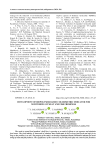
Development of biopolymer based colorimetric indicator for monitoring of meat and fish freshness
Статья научная
The need to extend food products' shelf lives is growing as a result of efforts to cut expenses and minimize food waste. The food industry is interested in solutions that would make it easy to keep food fresh and safe for as long as the product is on sale. The purpose of the study is to develop a biopolymer-based colorimetric indicator for monitoring of meat and fish freshness. The significance of the research is to provide food safety via control of the freshness using green and cheap methods. The objects of the study are natural and artificial indicators. The paper presents natural indicators such as curcumin, pomegranate, beetroots, and carrot juice which were incorporated into the compositions of food freshness indicators. The obtained indicators were compared with an artificial indicator, bromothymol blue, and phenol red, concerning their volatile amine monitoring. Additionally, a model of volatile amine release based on the different ammonia solutions was applied in the research. The response of freshness indicators was estimated by the observation of color changes. Compared to the artificial indicators, the curcumin and pomegranate juices gave a similar response. Beetroot and carrot juices did not provide a desirable color change. Further research was made on the development of biopolymer containing freshness indicators based on bromothymol blue and phenol red. The indicators were evaluated for their response to the spoilage of fish and meat samples in the test tubes and in food packaging. Thus, two artificial indicators could be incorporated into effective food freshness indicators for smart packaging.
Бесплатно
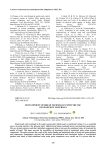
Development of bread technology with the use of grain raw materials
Статья научная
Bread made with sourdough is the leader among other baked goods in nutritionist ratings. It is a wonderful source of energy and has a low glycemic index. Making bread using sourdough meets environmental requirements. The use of grain mixtures and their individual components helps to increase the nutritional value of bread and the quality of bread. This paper presents the possibilities of developing bread of nutritional value using sprouted components. The article presents the results of the study. Quality and nutritional value of bread with grain mixtures and components. Organoleptic, physical and chemical, microbiological and rheological studies of semi-finished products and bread of high nutritional value using grain components were carried out. It is proven that the introduction of 28 % of sourdough starter with components from grains, whish were prepared and sprouted in advance, to the mass of flour has a positive effect on the nutritional value of bread.
Бесплатно
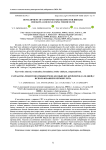
Development of compound feed recipes for broiler chickens (13-28 days) using vermiculite
Статья научная
Recently, in the CIS countries and abroad, to compensate for the mineral deficiency of feed rations and reduce their cost, substances of natural origin have increasingly begun to be used: zeolites, travertines, sapropels, bentonites, etc. The prlackblem of the widespread use of natural minerals in the diet of farm animals and poultry represents a pressing issue, given their distinctive properties, waste-free technology, environmental friendliness, and relatively low cost. One of these minerals suitable for use in poultry nutrition is vermiculite (hydromica, hydrous silicate of magnesium and iron of variable composition). The purpose of the study is to determine the physicochemical composition of vermiculite from the Kulantau deposit, and its use as a mineral in the production of animal feed and development of compound feed recipes for broiler chickens Cobb500. The physicochemical parameters of vermiculite, a natural mineral, have been determined. The research analyses were carried out in the research laboratory for assessing the quality and safety of food products of the Almaty Technological University. Feed recipes were developed at LLP “AGRO FIT KAPSHAGAY”. The compound feed recipes for Cobb 500 broiler chickens of 13-28 days were tested at JSC “Alel agro”, in poultry house No. 3.
Бесплатно
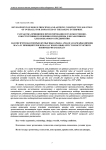
Статья
In article, it is stated development and justification of optimum parameters of design of new special clothes for workers of the baking industry. The practical value of research consists in definition of model characteristics of overalls taking into account ergonomic requirements and the correct selection of textile materials the considering working conditions in hot rooms. In result of the conducted scientific research, been get the new overalls for employees of the baking industry confirmed, which prove to be true with the patent for industrial sample No. 2227of RK.
Бесплатно
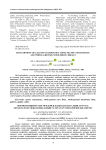
Development of galette technology using pectin concentrate and whole-ground flour from cereals
Статья научная
The food industry, covering industries that produce goods for consumption by the population, is a central link in ensuring food security. In this regard, high-quality, medically balanced and safe nutrition is of utmost importance. In this regard, the use of pectin substances as natural detoxifiers and whole-ground flour in the production of galets will solve the problem of meeting the needs of the population in safe food products with high nutritional and biological value. The aim of the work was to develop galettes of increased nutritional value using pectin concentrate and whole-ground flour from cereals. The article examines the effect of beetroot pectin concentrate on the quality of galettes made from a mixture of wheat and whole-ground corn, buckwheat flour. The optimal dosage of whole-ground corn flour of 15%, buckweat flour - 20.0% in the production of galets from wheat flour of the first grade, in which the quality of finished products is similar to control samples, is justified and determined. It was found that the nutritional and biological value of the developed galettes is higher than in the control samples, the products obtained meet the safety requirements of TR CU 021/2011.
Бесплатно
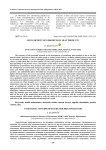
Development of gerodietary meat products
Статья научная
The relevance of the presented research on the development of gerodietary meat products is due to the fact that the relative preferences shown by older people to various protein sources, including animal protein sources such as red meat and poultry, as well as alternative plant-based protein sources, have not yet been identified. The food choices of older adults have not been studied, nor have their preferences and willingness to pay for different carbon tags depending on the protein source. The purpose of the study is to consider the current state and prospects for the development of gerodietary meat products. This article is an exploratory attempt to describe potential pathways for the development of nutritionally balanced gerodietary meat products aimed at helping older adults maintain an active and healthy aging process. The object of the study is age-related changes in the consumption of meat products. Age undoubtedly affects thresholds for recognizing basic tastes, especially sweet and salty. In particular, higher threshold values for sucrose and sodium chloride were found among older people compared to young people. Higher taste recognition thresholds create a natural need to add sugar and salt to food. The research methodology was a qualitative content analysis of the collected material. At the first stage, the texts of publications devoted to the production of gerodietary meat products were read and re-read in their entirety, that is, the so-called naive reading was carried out. Then thoughts were recorded regarding the integrity and relatively important elements of the publications read, arising on the basis of impressions aroused under the influence of naive reading. Further, all parts of publications related to the purpose of researching gerodietary meat products were divided into approximately identical semantic units. Qualitative content analysis involved grouping gerodiet meat products by identifying common characteristics between them, according to production processes and ingredients. At the next stage, the semantic units were subject to codification, and a number of categories with subcategories arose. Finally, after all the texts of the publications had been read, the texts were compared with the results of the undertaken content analysis, which made it possible to verify the reality of the coverage of the content of the publication texts and codes by the selected categories and subcategories in full.
Бесплатно
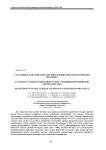
Development of goat cheese technology with high food safety
Статья научная
Бұл мақалада ешкі сүтіне пектин қосу арқылы тағамдық қауіпсіздігі жоғары ірімшік жасау технологиясы келтірілген. Алма пектинінің қасиеттері мен құрамы бойынша мәліметтер меңгеріліп, нәтижесінде пектинді ешкі сүтіне қосу әдісі, мөлшері анықталды. Технологияны жасау барысында, пастерлеу температурасында (74-75°С, ұстау мерзімі 15-20 секунд) ешкі сүтіне қосылатын пектиннің мөлшерінің ұйыту процессіне және түзілетін ұйытындыға әсерін зерттеу үшін, оны шикізат массасынан 0,10% дан 0,50% дейінгі ара-лықта түрлендірілді. Пектин қосылған ешкі сүті 33-350С температураға дейін салқын-датылып, жақсы ұйытынды түзілу үшін CaCl2 (100кг қоспаға 40г тұз), 3% сүтқышқылды бактериалардан тұратын ашытқы және мәйек ферменті қосылады. Ары қарай түзілген ұйытындыны өңдеу, қалыптау, тұздау, пісіп-жетілу процесстері жүргізілді. Өндірілген өнімнің тағамдық құндылықтары және қауіпсіздігі анықталды. В данной работе представлены результаты разработки технологии сыра из козьего молока с использованием пектина. Изучены состав и свойства яблочного пектина и обоснована возможность ее использования в производстве сыра из козьего молока. Установлены особенности свертывания козьего молока с яблочным пектином и формирования сыра при варьировании дозы пектина (в пределах от 0,10 до 0,50%). Отработаны технологические режимы (температура свертывания, пастеризации) производства сыра с яблочным пектином.
Бесплатно
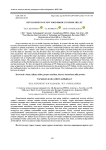
Development of new food products from millet
Статья научная
Proper nutrition can give us health, longevity and beauty. It assumes that the body regularly needs the necessary amount and many nutrients such as proteins, carbohydrates, fats, water, minerals, vitamins should be supplied in optimal proportions. In Kazakhstan, wheat is industrially produced only millet and semi-artisanal products such as "tari", "talkan" and "zhent" are produced. And wheat is an ideal product that can be attributed to the right raw materials, since the fact that it does not contain gluten, the raw materials are rich in B vitamins and protein. The research and development of the technology of the national cereal product talkan, creates an opportunity to expand the range of products, enrich the food market and the consumer's diet with a new cereal product rich in irreplaceable components, and developed taking into account forgotten original traditions and national culture. The analysis was carried out in the laboratory of Almaty Technological University. The calculated part of the finished product was analyzed to determine the chemical composition, the content of micro and macroelements. We have developed the technology of PN Talkan preserving all the useful properties. At the stage of approval of regulatory and technical documents for the production of PN Talkan. In this research work, the traditional product was improved in a new, most useful format. The technology of low-calorie millet talkan has been developed.
Бесплатно
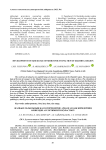
Development of size range of shoes for young men of Zhambyl region
Статья научная
The work has developed a size and full range of shoes for young men in the Zhambyl region. The measurement data of the feet of teenagers in the Zhambyl region were used to calculate the size range of shoes. The calculation of the structure of the size range of footwear for teenagers was based on the assumption that the normal distribution law accurately described the random variability of foot lengths. The results of calculations of a rational size range of shoes are described in detail and given in the tables. The structure of the size assortment of shoes was determined based on anthropometric studies of the shape and size of the feet of the teenagers and the results of the analysis of the distribution of the length of the feet. In this way, the average shoe size is 275 mm for young men in the Zhambyl region. It was revealed that 14 % of the young men required shoes in size 260, and the remaining 5 % of the young men had a foot size of 290mm. The measurements obtained in the study will make it possible to design shoes corresponding to the feet of teenagers for various purposes. The result of this study will be to provide teenagers in Kazakhstan with comfortable and fit shoes that correspond to non-standard feet, while preventing the appearance of various pathologies, thereby preserving the health of the younger generation.
Бесплатно
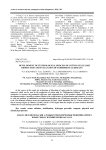
Статья научная
In the course of this study, the technology of bleaching of cotton pulp for various purposes has been improved, which can be used in the production of cotton pulp by "Khlopoprom-Cellulose" LLP and other enterprises to increase the production efficiency and competitiveness of the products obtained. The proposed development makes it possible to obtain cellulose with a high degree of polymerization and whiteness, as well as to solve the problem of stabilization and high decomposition rate of hydrogen peroxide in the technological cycle. The bleached cellulose meets the requirements of GOST (State Standard) 595-79 "Cotton cellulose" and has an average degree of whiteness of 90%, which is 5-6% higher than the samples of cotton cellulose bleached without the use of a hydrogen peroxide stabilizer.
Бесплатно
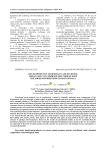
Статья научная
Functional meat products can be productively created by mutually replacing some components of the formulation with raw materials of plant origin, including vegetables and their secondary products with biologically active valuable substances. The purpose of the work is to develop technology and study the quality characteristics of meat bread with the enrichment of powder from tomato production waste in various proportions, taking into account consumer interest in products with high nutritional and biological value. The creation of meat loaf with the addition of tomato powder was carried out according to traditional schemes for the production of boiled sausage products. After determining the optimal amount of the herbal additive in the amount of 15%, samples of meat bread were prepared and examined for basic quality indicators. Experimental studies of prototypes were carried out using standard research methods. Based on the results of studying the physicochemical characteristics of meat loaf with tomato pomace powder, it was noticed that the pH value, water activity (aw), and moisture content in meat loaf samples naturally decreased after adding 15% tomato powder. This improves the shelf life and safety of meat products because they are more resistant to spoilage microorganisms. Based on the results of experimental studies, it can be concluded that the developed composition of meat loaf recipes with high nutritional and biological value, thanks to the use of secondary raw materials in the form of tomato pomace powder, and the use of processes with minimal energy consumption, is economically feasible.
Бесплатно
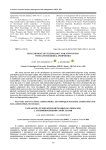
Development of technology for nonwovens with antimicrobial properties
Статья научная
The article presents data on the development of nonwovens with antimicrobial properties using anavidin, polyethylene glycol and copper sulfate. The production of nonwovens is booming all over the world. In terms of their properties, nonwovens successfully compete with fabrics and replace them, and in some properties they are superior to traditional textile materials. For the production of non-woven fabrics, more than half is still accounted for by natural fibers: cotton, wool and linen fibers, waste from the processing of natural fibers, regenerated fibers. In this work, the goal is to obtain nonwovens with antimicrobial properties. Technologies have been developed that give nonwovens stable antimicrobial properties. The physicochemical properties and mechanism of interaction of the applied components have been investigated. The optimal technological parameters for the production of antimicrobial nonwovens have been determined. The development of a new technology of nonwovens with improved physical, mechanical and functional properties will help to apply nonwovens in medicine and other areas that require bacteriostatic, bactericidal and fungicidal properties of textile materials. Therefore, in order to obtain nonwovens that would meet all the requirements of domestic and foreign enterprises, it is advisable to modify both fibers and impregnating compositions.
Бесплатно
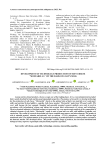
Development of technology production of soft cheese "Mozzarella" on the basis of goat’s milk
Статья научная
Among variety of food products, cheeses occupy one of the leading places. It is a concentrated protein product that is easily absorbed by body and has good organoleptic properties. The purpose of research is to develop technology for the production of soft cheese "Mozzarella" based on the optimal ratio of dairy raw materials (cow's and goat's milk) and enriched by food additive - paprika. Soft cheese product "Mozzarella" made from 50 % goat's milk: 50 % cow's milk became the best example. Standard and generally accepted research methods were used in work in accordance with technological scheme and taking into account latest achievements of science and technology. Physico-chemical indicators of finished products are presented. An x-ray spectroscopic analysis of the composition of chemical elements of soft cheese "Mozzarella", made in ratio of goat and cow milk, with addition of paprika, was carried out. The results of research showed that soft cheese contains many macro- and microelements. The product is rich in valuable proteins, vitamins and minerals, such as calcium - 27.21%, phosphorus - 18.80 %, and has high nutritional value. The implementation of the proposed technology in production allows to obtain products oriented to the domestic market. The developed cheese "Mozzarella" expands range of products, has increased nutritional and biological value, improves organoleptic and functional properties of product.
Бесплатно
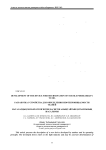
Development of the device for determination of textile permeability to oil
Статья научная
This article presents the description of a new device developed by authors and its operating principle. The developed device refers to the light industry and may be used for determination of textile material permeability to oil in order to produce special clothes for the workers of oil field. Operating principle of the device for the assessment of material permeability to oil is based on the measurement ofsliding friction coefficient.
Бесплатно
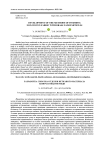
Development of the methods of finishing non-woven fabric with brass nanoparticles
Статья научная
Studies have been conducted on the process of obtaining brass nanoparticles by means of reduction with environmentally friendly preparations in order to give biocidal properties to non-woven fabric. The aim of the study is to modify a non-woven material using silver nanoparticles to give it biocidal properties. The effective composite preparation developed for biocidal finishing of textile materials is relatively inexpensive, environmentally and toxicologically safe. Its application opens up prospects for manufacturing a wide range of competitive, environmentally friendly, bio-resistant textile materials for various purposes. Process conditions of antibacterial finishing of textile materials were the followings: an aqueous solution with brass nanoparticles was sprayed onto the surface of a non-woven fabric, then dried and heat treated at 180 °C on a thermal press. To study the biocidal activeness of heat-treated material, a microbiological investigation was carried out. Non-woven fabric processed on the basis of brass nanoparticles obtains pronounced antifungal activeness in terms of investigating C.albicansATCC 2091 and C.albicansATCC 10231 test strains. Also, experiments on toxic and skin-irritating effects of non-woven material processed by the proposed method showed its safety for human health. The developed product based on silver nanoparticles provides high indicators of bio-resistance of textile material and meets the environmental requirements for textile auxiliary substances. In the production of nonwovens, processing with this composition can be combined with the emulsification of a mixture of fibers, or carried out after the formation of the canvas with subsequent heat treatment and calendering.
Бесплатно
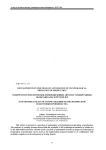
Developments in the field of automation of technological preration of production
Статья научная
This article is devoted to a question of automation of technological preparation of production. The analysis of existing systems showed that the available CAD technological modules of clothes act as the information directory. Results of the research of automation systems of design of technological preparation of production can be used as the independent program module or in combination with available complexes at the enterprises of sewing branch.
Бесплатно
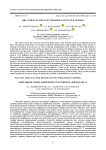
Dry-curing of melon by infrared-convective method
Статья научная
The article presents the results of research on drying melon of the Torpeda variety in an infrared-convective dryer. The purpose of the study is to develop a method for drying melon using artificial drying, which will ensure reducing of duration of the process, as well as reducing contamination of the product. To solve this problem, a technology for infrared-convective drying of melon has been developed, including preparation of raw materials, peeling and removing seeds, washing, cutting, blanching in a 0.2% solution of citric acid for 3 minutes, infraredconvective drying of slices in a dryer cabinet "Universal-SD-4" at the temperature of heaters 50÷70 0C and an air speed of 7 m/s, holding at room temperature for 24 hours to moisture levelling, packaging and storage. The study discovered that the combination of infrared heating and convective removal of evaporated moisture made it possible to significantly intensify the dehydration process. It maintains good organoleptic characteristics compared to air-solar drying as well. The duration of the process varied from 5 to 8 hours instead of several days when drying in the sun. All curves are characterized by clearly defined periods of the beginning of drying, constant and decreasing drying rate. The optimal mode of infrared-convective drying is a temperature of 55 0C and a slice size of 50×50×15 mm, which ensures an elastic texture and light color of dried products. A study of the chemical composition showed that carbohydrates predominate in dried slices (79.8%), and the energy value of 100 g of product is 1348.8 kJ or 322 kcal. The research results contribute to the development of theory and technology of melon drying. The use of the developed method of infrared-convective drying will expand the possibility of industrial processing of melon.
Бесплатно
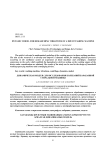
Dynamic model for researching vibrations of a drum washing machine
Статья научная
The article is devoted to the mathematical modeling of the processing of material in the drum washing and squeezing machines. The aim of the study is to develop and improve a dynamic model for studying the physical processes occurring in the oscillatory suspension system of drum machines and centrifuges. In the work, analytical expressions are obtained that establish the dependence of the forces acting on the working bodies of the device in question. The results of the study can be used in the design of household washing and squeezing machines and centrifugal devices.
Бесплатно
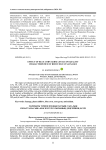
Effect of blue corn germ levels on quality characteristics of reduced-fat sausages
Статья научная
The impact of reducing pork fat levels from 21% to 5% with varying concentrations of blue corn germ (2%, 3.5%, 5%, 8.5%, 13.5%, and 18.5%) on the physicochemical and textural properties of low-fat frankfurters was investigated. Decreased fat content correlated with reduced cooking loss, moisture content, and total lightness, redness, and yellowness of the sausages. Conversely, increased firmness and chewiness were observed. Frankfurters containing higher levels of blue corn germ exhibited enhanced firmness and chewiness compared to those with lower levels. Analysis of frankfurters with different fat and blue corn germ levels revealed an increase in hardness until the 8th day of storage, followed by a decrease by the 14th day. Optimal results were observed in samples containing 20% pork fat and 5% blue corn germ. However, excessive blue corn germ inclusion did not yield positive effects.
Бесплатно
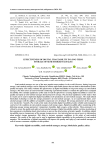
Effectiveness of digital traceability in long-term storage of semi-smoked sausages
Статья научная
Semi-smoked sausages are one of the most popular meat products in the world. However, during long-term storage, semi-smoked sausages can be subjected to various unfavorable factors that can lead to deterioration of their quality and safety. This study evaluates the effectiveness of digital traceability in long-term storage of semi-smoked sausages. The main areas of research include conducting experimental studies to evaluate the effectiveness of digital traceability. The scientific significance of the study reveals the effectiveness of using digital traceability to ensure the quality and safety of semi-smoked sausages during long-term storage. The practical significance of the study is that its results can be used to implement digital traceability in the production of semi-smoked sausages. The study utilized blockchain technology to track the storage parameters of semi-smoked sausages. As an experimental object, semismoked sausages with the addition of vegetable components were developed. The storage parameters of the sausages were tracked for 3 months. The results of the study showed that digital traceability provides reliable and transparent control over the condition of semi-smoked sausages at all storage stages. Digital traceability allows monitoring of the following sausage storage parameters: temperature, humidity, light, oxygen, carbon dioxide. These parameters are critical to ensure the quality and safety of semi-smoked sausages. Digital traceability enables real-time monitoring of these parameters, facilitating timely interventions to prevent the deterioration of product quality. In addition, digital traceability ensures transparency of the sausage storage process. Any interested person can get access to information about product storage parameters. This helps to increase consumer confidence in the safety of semi-smoked sausages. The results of the study can be used to implement digital traceability in the production of semi-smoked sausages. The introduction of digital traceability will improve the quality and safety of semi-smoked sausages, as well as increase consumer confidence in this product.
Бесплатно

